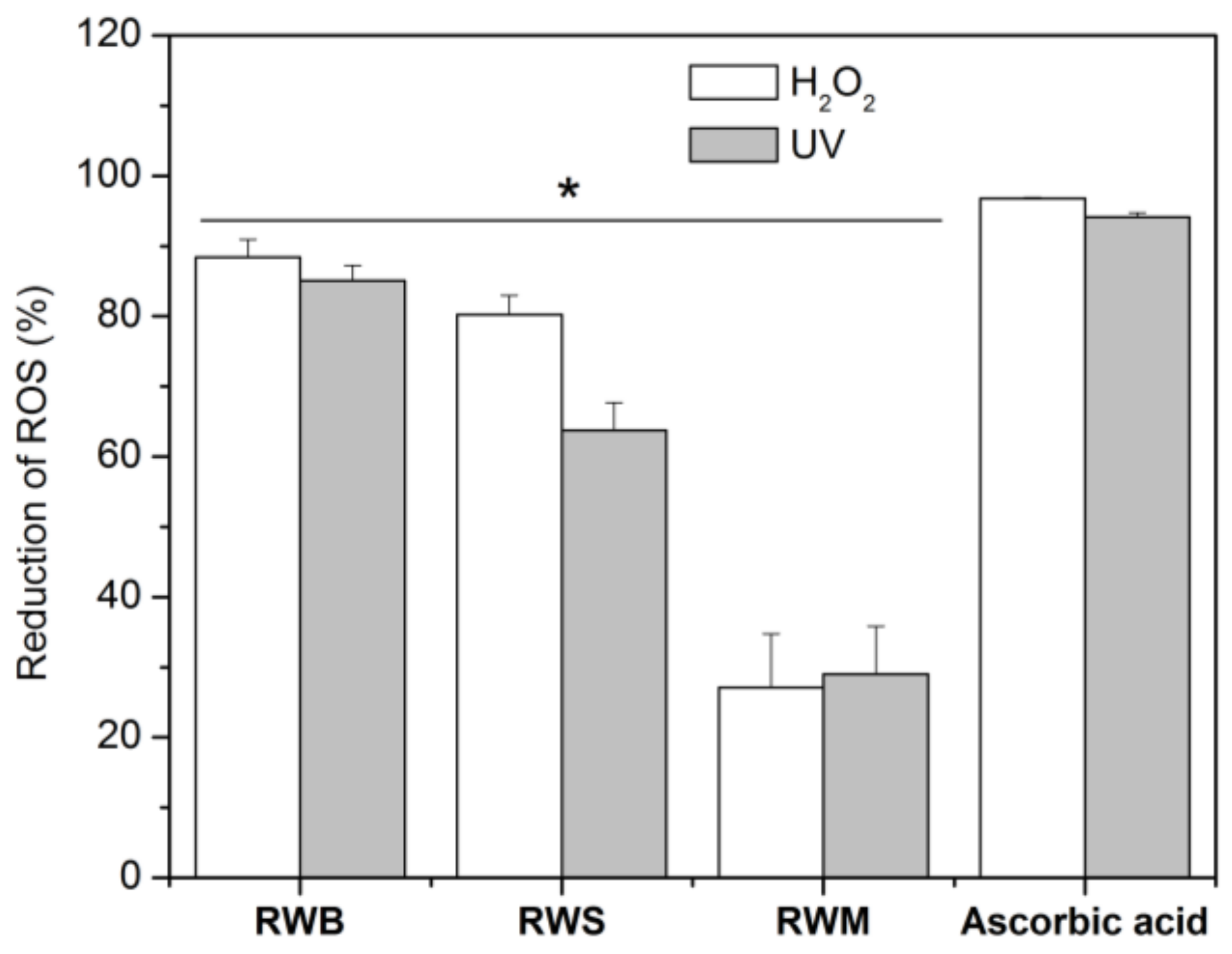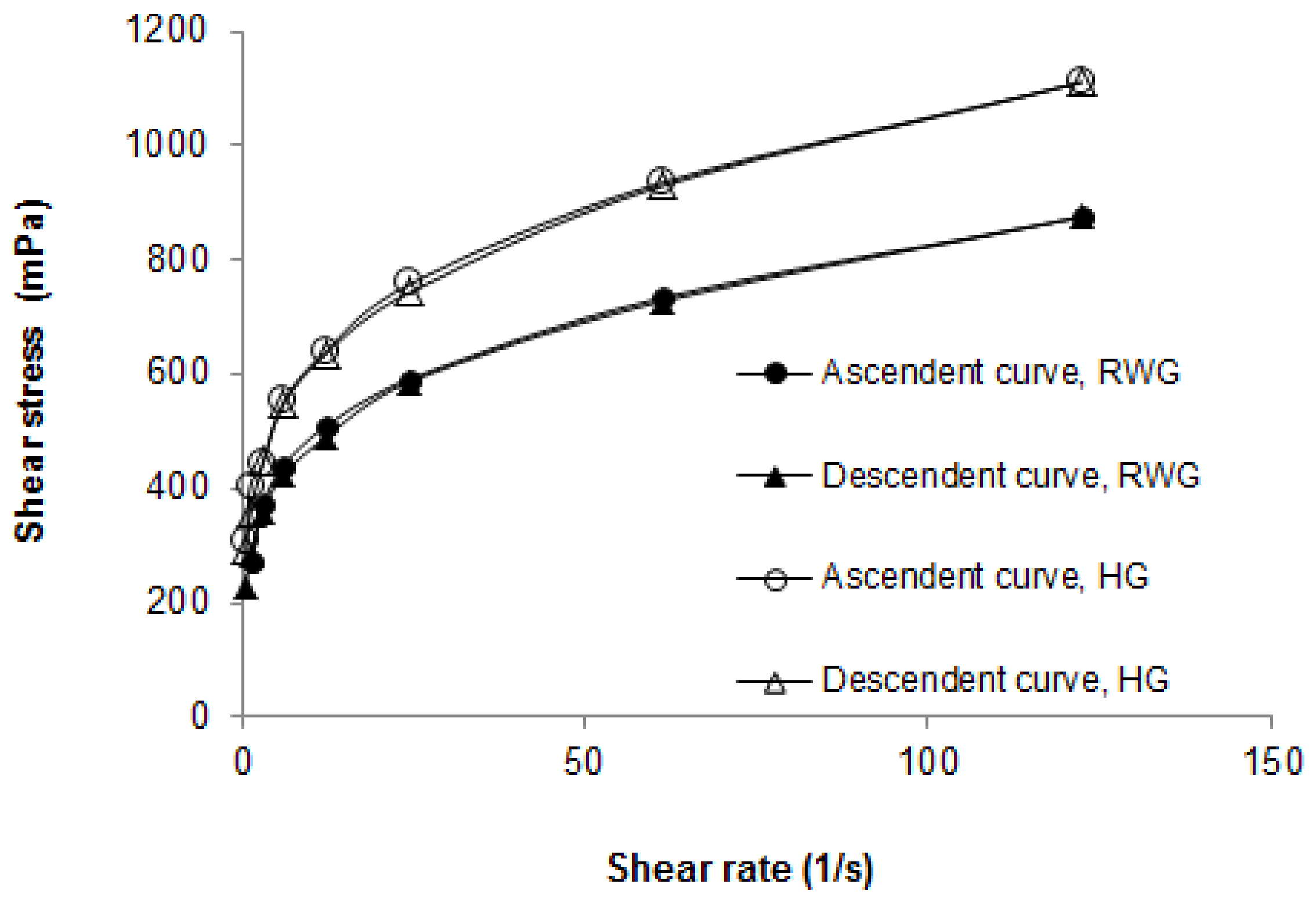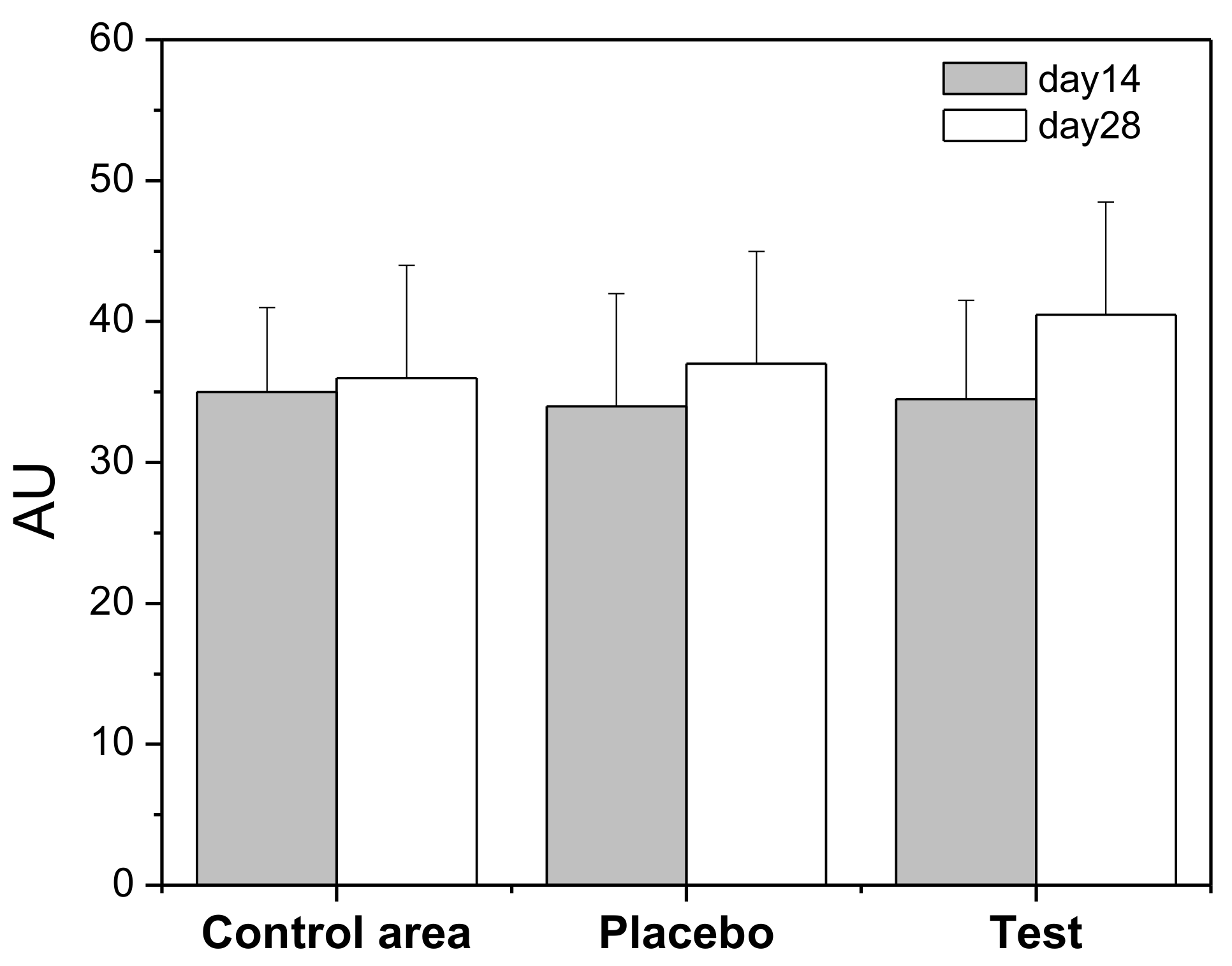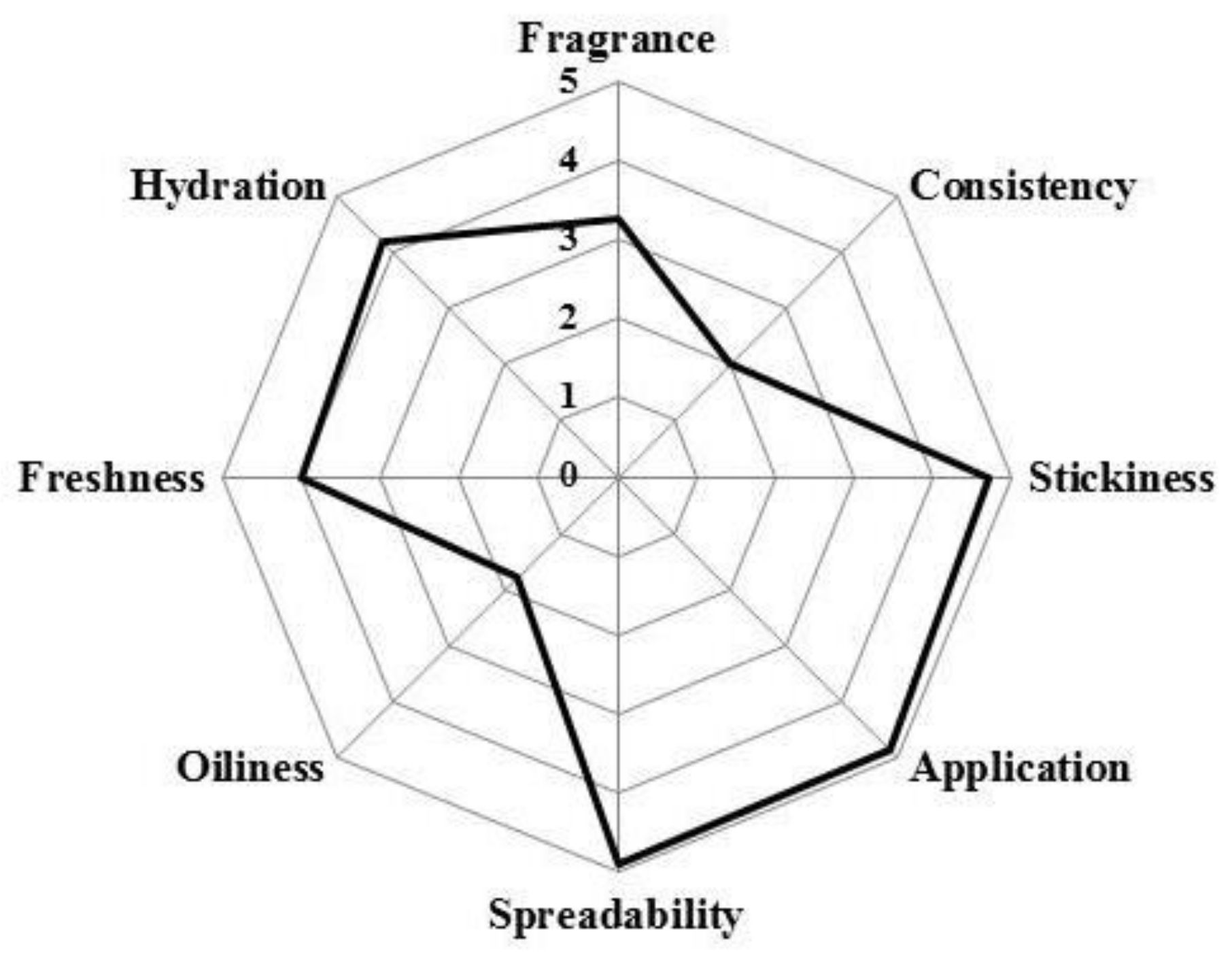Rice Water: A Traditional Ingredient with Anti-Aging Efficacy
Abstract
1. Introduction
2. Materials and Methods
2.1. Materials
2.2. Rice Water Preparation by Three Different Procedures
2.3. Rice Water Characterization
2.3.1. Physical Characterization
2.3.2. Dry Residue Assay
2.3.3. Carbohydrates Determination by Phenol Sulphuric Acid Method
2.3.4. Total Protein by Kjeldahl Method
Mineralization
Distillation
2.3.5. Analysis of Fat by Rose Gottlieb Method
2.3.6. Total Phenolic Compounds by Folin–Ciocalteu Method
2.3.7. In Vitro Studies
Cell Viability
Reactive Oxygen Species (ROS) Production Measurement
Enzymatic Inhibition Assay
2.3.8. Antimicrobial Activity
2.4. Rice Water Gel (RWG) Preparation
2.5. Rice Water Gel Physico-Chemical Characterization
2.6. In Vivo Studies
2.6.1. Local Compatibility Tests on Human Skin (HRIPT)
2.6.2. Biological Effects of Rice Water Gel
2.6.3. Rice Water Gel Sensory Analysis
2.7. Statistical Analysis
3. Results and Discussion
3.1. Preparation and Characterization of Rice Water
3.2. Evaluation of Rice Water In Vitro Anti-Aging Properties
3.3. Preparation and Characterization of Rice Water Hydrogel
3.4. Biological Effects and Cosmetic Properties of Rice Water Hydrogel
4. Conclusions
Acknowledgments
Author Contributions
Conflicts of Interest
References
- Coppini, D.; Paganizzi, P.; Santi, P.; Ghirardini, A. Capacitá protettiva nei confronti delle radiazioni solari di derivati di origine vegetable. Cosm. News 2001, 136, 15–20. [Google Scholar]
- Lerma-García, M.J.; Herrero-Martínez, J.M.; Simó-Alfonso, E.F.; Mendonça, C.R.B.; Ramis-Ramos, G. Composition industrial processing and applications of rice bran gamma-oryzanol. Food Chem. 2009, 115, 389–404. [Google Scholar] [CrossRef]
- Ha, S.J.; Park, J.; Lee, J.; Song, K.M.; Um, M.Y.; Cho, S.; Jung, S.K. Rice bran supplement prevents UVB-induced skin photoaging in vivo. Biosci. Biotechnol. Biochem. 2018, 1–9. [Google Scholar] [CrossRef] [PubMed]
- Rigo, L.A.; da Silva, C.R.; de Oliveira, S.M.; Cabreira, T.N.; de Bona da Silva, C.; Ferreira, J.; Beck, R.C. Nanoencapsulation of rice bran oil increases its protective effects against UVB radiation-induced skin injury in mice. Eur. J. Pharm. Biopharm. 2015, 93, 11–17. [Google Scholar] [CrossRef] [PubMed]
- Bernardi, D.S.; Pereira, T.A.; Maciel, N.R.; Bortoloto, J.; Viera, G.S.; Oliveira, G.C.; Rocha-Filho, P.A. Formation and stability of oil-in-water nanoemulsions containing rice bran oil: In vitro and in vivo assessments. J. Nanobiotechnol. 2011, 9, 44. [Google Scholar] [CrossRef] [PubMed]
- Saba, E.; Lee, C.H.; da Jeong, H.; Lee, K.; Kim, T.H.; Roh, S.S.; Kim, S.H.; Rhee, M.H. Fermented rice bran prevents atopic dermatitis in DNCB-treated NC/Nga mice. J. Biomed. Res. 2016, 30, 334–343. [Google Scholar] [CrossRef] [PubMed]
- Kanlayavattanakul, M.; Lourith, N.; Chaikul, P. Jasmine rice panicle: A safe and efficient natural ingredient for skin aging treatments. J. Ethnopharmacol. 2016, 193, 607–616. [Google Scholar] [CrossRef] [PubMed]
- Manosroi, A.; Chutoprapat, R.; Abe, M.; Manosroi, W.; Manosroi, J. Anti-aging efficacy of topical formulations containing niosomes entrapped with rice bran bioactive compounds. Pharm. Biol. 2012, 50, 208–224. [Google Scholar] [CrossRef] [PubMed]
- Choi, J.S.; Park, J.B.; Moon, W.S.; Moon, J.N.; Son, S.W.; Kim, M.R. Safety and efficacy of rice bran supercritical CO2 extract for hair growth in androgenic alopecia: A 16-week double-blind randomized controlled trial. Biol. Pharm. Bull. 2015, 38, 1856–1863. [Google Scholar] [CrossRef] [PubMed]
- De Paepe, K.; Hachem, J.P.; Vanpee, E.; Roseeuw, D.; Rogiers, V. Effect of rice starch as a bath additive on the barrier function of healthy but SLS-damaged skin and skin of atopic patients. Acta Derm. Venereol. 2002, 82, 184–186. [Google Scholar] [CrossRef] [PubMed]
- Anwunobi, A.P.; Emeje, M.O. Recent applications of natural polymers in nanodrug delivery. J. Nanomed. Nanotechnol. 2011, S4, 002. [Google Scholar] [CrossRef]
- Garbacki, N.; Gloaguen, V.; Damas, J.; Hoffmann, L.; Tits, M.; Angenot, L. Inhibition of croton oil-induced oedema in mice ear skin by capsular polysaccharides from cyanobacteria. Naunyn Schmiedebergs Arch. Pharmacol. 2000, 361, 460–464. [Google Scholar] [CrossRef] [PubMed]
- Marto, J.; Ruivo, E.; Lucas, S.D.; Gonçalves, L.M.; Simões, S.; Gouveia, L.F.; Felix, R.; Moreira, R.; Ribeiro, H.M.; Almeida, A.J. Starch nanocapsules containing a novel neutrophil elastase inhibitor with improved pharmaceutical performance. Eur. J. Pharm. Biopharm. 2018, 127, 1–11. [Google Scholar] [CrossRef] [PubMed]
- DuBois, M.; Gilles, K.A.; Hamilton, J.K.; Rebers, P.A.; Smith, F. Colorimetric method for determination of sugars and related substances. Anal. Chem. 1956, 28, 350–356. [Google Scholar] [CrossRef]
- Lynch, J.M.; Barbano, D.M. Kjeldahl nitrogen analysis as a reference method for protein determination in dairy products. JAOAC Int. 1999, 82, 1389–1394. [Google Scholar]
- Heinrich, C. Use of the Rose-Gottlieb method for rapid gravimetric fat determination with the Heraeus apparatus. Deutsche Milchwirtschaft 1970, 21, 797–798. [Google Scholar]
- Marto, J.; Ascenso, A.; Gonçalves, L.M.; Gouveia, L.F.; Manteigas, P.; Pinto, P.; Oliveira, E.; Almeida, A.J.; Ribeiro, H.M. Melatonin-based pickering emulsion for skin’s photoprotection. Drug Deliv. 2016, 23, 1594–1607. [Google Scholar] [CrossRef] [PubMed]
- Lucas, S.D.; Gonçalves, L.M.; Carvalho, L.A.; Correia, H.F.; Da Costa, E.M.; Guedes, R.A.; Moreira, R.; Guedes, R.C. Optimization of O3-acyl kojic acid derivatives as potent and selective human neutrophil elastase inhibitors. J. Med. Chem. 2013, 56, 9802–9806. [Google Scholar] [CrossRef] [PubMed]
- Marzulli, F.N.; Maibach, H.I. Contact allergy: Predictive testing in man. Contact Dermatitis 1976, 2, 1–17. [Google Scholar] [CrossRef] [PubMed]
- ICHE6(R1). ICH harmonised tripartite guideline: Guideline for good clinical practice E6 (R1), in International Conference on Harmonisation of Technical Requirements for Registration of Pharmaceuticals for Human Use. 1996. Available online: https://www.ich.org/fileadmin/Public_Web_Site/ICH_Products/Guidelines/Efficacy/E6/E6_R1_Guideline.pdf (accessed on 1 April 2018).
- Massaretto, I.L.; Alves, M.F.; Mira, N.V.; Carmona, A.K.; Marquez, U.M. Phenolic compounds in raw and cooked rice (Oryza sativa L.) and their inhibitory effect on the activity of angiotensin I-converting enzyme. J. Cereal Sci. 2011, 54, 236–240. [Google Scholar] [CrossRef]
- Walter, M.; Marchesan, E. Phenolic compounds and antioxidant activity of rice. Braz. Arch. Biol. Technol. 2011, 54, 371–377. [Google Scholar] [CrossRef]
- Tian, S.; Nakamura, K.; Kayahara, H. Analysis of phenolic compounds in white rice, brown rice, and germinated brown rice. J. Agric. Food Chem. 2004, 52, 4808–4813. [Google Scholar] [CrossRef] [PubMed]
- Awasthi, S.; Das, A.; Bhattacharjee, C. Physico-chemical properties of different kind of rice water and their effect on diarrhoea causing bacteria and dandruff causing fungi. J. Phytol. 2011, 3, 33–36. [Google Scholar]
- Alcázar-Alay, S.; Almeida Meireles, M.A. Physicochemical properties, modifications and applications of starches from different botanical sources. Food Sci. Technol. Campinas 2015, 35, 215–236. [Google Scholar] [CrossRef]




| Quantitative Composition (%, w/w) | ||
|---|---|---|
| Composition | RWG | HG |
| Sodium acrylates copolymer and lecithin 1 | 2.0 | 2.0 |
| Methylpropanediol, caprylyl glycol and phenylpropanol 2 | 2.0 | 2.0 |
| Water prepared by the boiling process (RWB) | 96.0 | - |
| Deionized water | - | 96.0 |
| 1 LecigelTM; 2 Dermosoft® OMP | ||
| Parameters | RWB | RWS | RWM |
|---|---|---|---|
| pH at 20 °C | 6.8 | 5.4 | 6.0 |
| Conductivity (μs/cm 25 °C) | 947 | 1654 | 492 |
| Turbidimetry (TNU) | 91 | 283 | 100 |
| Dry Residue (%) | 0.45 | 2.59 | 0.10 |
© 2018 by the authors. Licensee MDPI, Basel, Switzerland. This article is an open access article distributed under the terms and conditions of the Creative Commons Attribution (CC BY) license (http://creativecommons.org/licenses/by/4.0/).
Share and Cite
Marto, J.; Neves, Â.; Gonçalves, L.M.; Pinto, P.; Almeida, C.; Simões, S. Rice Water: A Traditional Ingredient with Anti-Aging Efficacy. Cosmetics 2018, 5, 26. https://doi.org/10.3390/cosmetics5020026
Marto J, Neves Â, Gonçalves LM, Pinto P, Almeida C, Simões S. Rice Water: A Traditional Ingredient with Anti-Aging Efficacy. Cosmetics. 2018; 5(2):26. https://doi.org/10.3390/cosmetics5020026
Chicago/Turabian StyleMarto, Joana, Ângela Neves, Lídia Maria Gonçalves, Pedro Pinto, Cristina Almeida, and Sandra Simões. 2018. "Rice Water: A Traditional Ingredient with Anti-Aging Efficacy" Cosmetics 5, no. 2: 26. https://doi.org/10.3390/cosmetics5020026
APA StyleMarto, J., Neves, Â., Gonçalves, L. M., Pinto, P., Almeida, C., & Simões, S. (2018). Rice Water: A Traditional Ingredient with Anti-Aging Efficacy. Cosmetics, 5(2), 26. https://doi.org/10.3390/cosmetics5020026










